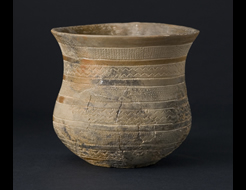|
||||||||||||||||||||||||||||||||
|
|
Museum of: Budapest | |||||||||||||||||||||||||||||||
| Name of the artefact: Bell beaker | ||||||||||||||||||||||||||||||||
|
500 metres from the main channel of the Danube 3 graves
of the Bell Beaker Csepel Group were found. The NS-oriented grave
contained a corpse lying on its left side in an extremely contracted
position. The skull, lying on the Northern side, was destroyed by
gaspipelines. Three bell beakers and a vessel with four holes on its
bottom were put beside the skeleton, possibly with food and drink to serve
for the afterlife. A decorated bone pendant and a stone blade was found
next to the shoulders of the skeleton; a curved wristguard with holes at
its corners was on the left wrist. A copper dagger was placed among the
pottery. |
||||||||||||||||||||||||||||||||
|
WHERE IS IT AND MAIN
CHARACTERISTICS |
STATE |
|||||||||||||||||||||||||||||||
|
Department: |
Department of Prehistoric and Migration
Period |
Preservation: |
Very good | |||||||||||||||||||||||||||||
|
Inventory number: |
BTM 2005.14.4. |
Restauration: |
Restored | |||||||||||||||||||||||||||||
|
Name of the artefact: |
Bell beaker |
Completeness: |
Complete | |||||||||||||||||||||||||||||
|
Object type: |
Vessel/Anphora |
|||||||||||||||||||||||||||||||
|
Material: |
Clay |
|||||||||||||||||||||||||||||||
|
Methof of manufacture: |
Hand made |
|||||||||||||||||||||||||||||||
|
Decoration
type: |
Stamp |
|||||||||||||||||||||||||||||||
|
Distinctive mark: |
- |
|||||||||||||||||||||||||||||||
|
DIMENSIONS |
PERIOD OF USE |
|||||||||||||||||||||||||||||||
|
Length (mm): |
- |
Epoque: |
Early Bronze Age |
|||||||||||||||||||||||||||||
|
Heigth
(mm): |
110 |
Culture: |
Bell Beaker Csepel Group |
|||||||||||||||||||||||||||||
|
Diameter
(mm): |
120 |
Period: |
Early Bronze Age 2 |
|||||||||||||||||||||||||||||
|
Width (mm): |
- |
Face: |
Early |
|||||||||||||||||||||||||||||
|
Thickness (mm): |
50 |
Absolute chronology: |
2500-2100 BC |
|||||||||||||||||||||||||||||
|
Weight
(g): |
- |
|||||||||||||||||||||||||||||||
DISCOVERY |
||||||||||||||||||||||||||||||||
|
Date: |
1999 |
Country: |
Hungary |
|||||||||||||||||||||||||||||
|
District: |
Budapest, XXI |
Town hall affiliation: |
- |
|||||||||||||||||||||||||||||
|
Village: |
- |
Discovery findspot: |
Budapest, Csepel-sziget, II. Rákóczi Ferenc
út |
|||||||||||||||||||||||||||||
|
Condition of discovery: |
Archaeological excavation |
Discovery type: |
Pit |
|||||||||||||||||||||||||||||
|
ANALYSES – DETERMINATIONS |
FILLED IN BY |
|||||||||||||||||||||||||||||||
|
Type: |
- |
Name: |
Anna Endrődi |
|||||||||||||||||||||||||||||
|
Laboratory: |
- |
Institution: |
Budapest History Museum |
|||||||||||||||||||||||||||||
|
No./Code: |
- |
Date: |
20/10/2005 |
|||||||||||||||||||||||||||||
|
DEEPENINGS |
||||||||||||||||||||||||||||||||
|
Morphology of the object: |
||||||||||||||||||||||||||||||||
|
Red-painted, bell beaker form vessel. |
||||||||||||||||||||||||||||||||
|
Decoration: |
||||||||||||||||||||||||||||||||
|
The bell beaker is decorated in bands with stamped
impressions. The vessel can be divided into 7 zones, where bands of
pricked points and zigzag motifs interchange, with undecorated streaks in
between. Remains of red paint can be seen on the pottery. A small hole was
drilled below the rim. |
||||||||||||||||||||||||||||||||
|
Inscription: |
||||||||||||||||||||||||||||||||
|
- |
||||||||||||||||||||||||||||||||
|
Analogies: |
||||||||||||||||||||||||||||||||
|
Analogies can be found at other Hungarian sites, e.g.
the scattered cremation burials of Békásmegyer and skeletal graves of
Szigetszentmiklós. The bell beakers occur with similar forms, colours and
decoration throughout Europe where the culture exists. This contracted
skeletal grave and its finds can be connected to the Bell Beaker people of
the Czech-Moravian region. |
||||||||||||||||||||||||||||||||
|
Interpretation: |
||||||||||||||||||||||||||||||||
|
The deceased was presumably a warrior who was placed
contracted into the grave, possibly to represent him while asleep, placing
next to him his weapon (the copper dagger) and fixing the wristguard onto
his arm, which once protected him from the lashing of the flexed
bowstring. Pendants (made of bone and stone) hung possibly by string from
his neck. The bell beakers found in the grave once contained food and
drink, which were placed beside the deceased amidst the performance of
religious rituals. |
||||||||||||||||||||||||||||||||
|
Bibliography: |
||||||||||||||||||||||||||||||||
|
Literature: Endrődi Anna-Horváth M. Attila: Kora
bronzkori és avar sírok Budapest, Csepel-szigeten. (Early Bronze Age and
Avar graves at Budapest, Csepel-Island.) Archaeological Investigations in
Hungary 1999. 27.47. Budapest 2002. |
||||||||||||||||||||||||||||||||

